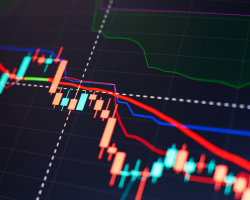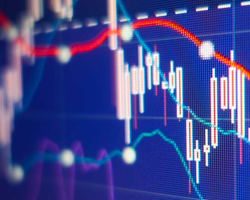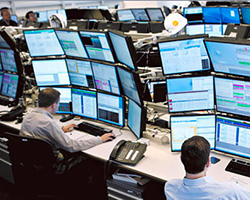Market Correction: What Does It Mean?

Any price movement can move in one direction only for a limited period of time. After that the quote changes its trend, goes to a sideways trend or starts an opposite trend. It is quite difficult to predict such changes, that is why modern traders invent more and more methods of market analysis. By understanding when a correction begins, traders can determine the probability of the next reversal and place appropriate orders.
What is a Market Correction?
Let us start with the concept of a trend. The general direction of quotes movement on the chart is called a trend. As a rule, the asset price moves in a wave-like manner over time. However, its general movement is directed upwards, downwards or stays on one level. The following types of trends are distinguished:
Uptrend (bullish), which are caused by the growth of quotations;
Downtrend (bearish) trends which appear when prices are falling;
Sideways trends (flat), the price stays on one level.
At the same time correction is called a short-term deviation of quotes from the current trend. As a rule deviation is 10% or more of the current values. It can be expressed as price fall as well as its growth which goes against the trend. At that, the general direction doesn't turn and doesn't stop.
Here is an example. There is a rising trend in the market for a particular asset. On one day the price dipped sharply by 10%, and then within a while it returned to its former positions. A correction took place. Its length in time can be quite different, from one day to several months. For the most part, this parameter depends on the strength of the trend.
The correction is simply understood as the desire of the price to correct in the direction of its fair value. Often it happens after the rapid growth because of high demand from buyers. In this case the general growing trend is preserved.
In trading, the correction is most often said about the fall in prices during a prolonged trend. The correction is also called a pullback.
Types of Correction
There are two main types of correction in trading:
- Ascending;
- Descending.
The first is when the main trend of the asset on the market is moving downward, but prices have started to go up. The descending correction takes place when the trend is up and prices have started to go down.
Some traders in the market refer to a sideways movement as a pullback. In this case, the correction is called sideways, side range, consolidation or flat. Anyway, a sideways movement has no clearly defined direction. The quotes keep on one level and go sideways. As a rule, the sideways movement comes after a strong fall or rise of the quotes.
The sideways correction is a kind of a pause for the market and traders before they return to the main movement. Usually during this time the buyers and sellers are equal and nobody is able to form a new trend.
How to Distinguish a Correction from a Reversal
Many people probably wonder how to tell the difference between the beginning of a long bearish market and a correction. When does a market decline really tell you to refrain from investing in stocks and when does it present a great opportunity to buy at low prices?
As mentioned above, every situation is different. But there are a few key points that usually distinguish a temporary correction from a market crisis:
- A correction is caused more by expectations than by actual problems
The distinction is that the real problems that would cause asset values to fall have not yet occurred. The market is just waiting for them in the future, basing its forecasts on various indirect factors. Meanwhile, earlier the market reacted much more reservedly to similar signals.
Such behavior of participants may indicate that there is more psychological effect than real problems.
- The factors which provoked the fall can be mitigated by the actions of the government or regulators
The U.S. market correction in late 2018 occurred amid escalating trade wars, expectations of rising interest rates and a government shutdown. As a result, the Fed refused to raise rates, the U.S. and China attempted a trade truce that lasted until May, and the government shutdown did not cause significant damage across the financial market.
Thus, if there is reason to believe that the government has all the necessary tools at its disposal to support the market, it is likely that the current correction will not escalate into something more serious.
- Corrections often reverse upon reaching the 200-day or the 200-week Moving Average
During a correctional decline, many investors closely watch the market and wait for an opportune moment to buy at attractive prices. However, fundamental analysis is unable to tell you where the reversal may occur. Then the technical analysis comes to the rescue. The 200-period Moving Average is a very popular indicator among the world's investors for determining the moment to enter the market. It is most commonly used on a daily chart, but investors can focus on weekly time frames for deeper declines.
What Causes Correction
There are several main reasons for the beginning of corrections. Thus, the market sentiment has a strong influence on the movement of quotes. As a rule, the fears about the financial statements or the success of the company put pressure on the price of the asset or push it. Also, the correction is a result of changes in the law, economic news, natural disasters and other events. As a result, traders start to sell assets, the number of buyers decreases and the price falls.
The psychological mood of traders also plays an important role. If the price has reached its peak or extremely high value, potential buyers refuse to buy an asset at the current price, or they expect an imminent correction. In other words, they see the potential for falling.
At the same time, the potential for growth is much harder to predict. A small negative movement can make many traders and investors start to sell the asset.
It is also worth remembering about the existence of margin trading and Stop Losses. If an investor purchased the asset at the price peak, then during a descending correction there is a risk of losing part of the invested funds. If it develops further, even losses are possible.
Traders who trade on margin and use leverage can incur the highest losses in this situation. If assets begin to lose value, the investor will receive a margin call from the broker. It means that at the current price his debt increases. Therefore, it is necessary to replenish the balance of the brokerage account, otherwise the broker will close the positions at the current value.
In such a scenario, some traders begin to actively sell the asset at the current price. As a result, quotes fall and the price no longer corresponds to reality.
How Often the Market Corrections Occur
Small and short corrections in the value of assets on the markets occur frequently. Those who have been trading for more than a year are bound to encounter both falling and rising prices.
In terms of averages, a deviation of more than 10% occurs about once a year. Major corrections within the range of 20-40% occur less frequently, usually once in 5-7 years. Such events are able to affect related assets in the sector.
At the same time the exchange remembers the most real collapses. During such periods, quotes on the market fall by 40-70%, leading to the bankruptcy of companies. Fortunately, it happens very rarely and only during the events of world scale. For example, the collapse of quotes on stock markets occurred in 2008, when the global financial crisis began.
The last serious trend correction took place in early 2020. It affected all markets and stock exchanges. The reasons were the coronavirus pandemic, border closures and restrictive measures affecting most businesses in all countries.
How a Correction in Trading Takes Place
The correction process in the market usually takes place in two waves of selling assets. At the beginning of the first wave, the price holds at the maximum level in sideways movement mode. So far, the quotes are not going to rise more or go down. This situation discourages new buyers who are not willing to buy at high prices or who forecast an imminent correction.
As a rule, some event initiates the movement of the first wave. For example, negative financial statements, a public announcement, changes in the legislation, etc. The number of sell orders increases like an avalanche, traders want to get rid of assets as quickly as possible, reducing the value. Competition among sellers is formed.
Here the second wave begins and the Stop Loss orders are triggered. At the same time, most investors are not willing to buy the rapidly decreasing asset. Such a development is largely due to the reaction of the speculators, who sell the shares at the slightest danger. Such behavior increases the volatility of the asset, which negatively affects quotations.
Then the situation begins to improve. Usually everything happens in one day from the beginning of the trading session. The number of buy orders for the fallen asset increases, the news background is normalized. Growth in demand for the asset pushes quotes up, the trend returns to its course.
Pay attention: after the pullback, the return to previous levels happens not always. Sometimes the price falls far short of its previous value, and the comeback itself takes a long time.
How long does the correction last?
Usually a correction in the market lasts about 3-4 months. From a trading perspective, that's a short period of time. However, it can seem dangerous to novice investors to hold an asset that has lost in value for so long. Such a development causes psychological pressure that can lead to erroneous and unprofitable operations.
In trading it is important to learn how to keep cool and rational thinking. You must learn to use the current situation competently and make profit out of it.
It is quite difficult to foresee a new correction on the market. The forex market itself is only possible events and probabilities. It is much more useful to always keep in mind that a pullback will happen sooner or later. It is useful to have a personal plan of action for such developments. Likewise, it is difficult to predict exactly which assets will be affected by a new market correction. It is best to follow agency analysis and news feeds. Everything has its prerequisites.
Pros and Cons of the Market Correction
Like any other phenomenon in the market, correction has advantages and disadvantages. It is important to remember about them and to be able to use them in trading.
Advantages of correction:
If an asset is overvalued and is clearly worth more than its real value, a pullback shifts the level closer to the fair price. As a result, for instance, the stock becomes more accessible to other investors. From this perspective, we, as potential buyers, get the opportunity to buy the desired securities. This is called an asset revaluation.
Disadvantages of correction:
Sometimes a correction ends in a complete trend reversal. Then the market becomes bearish, and the return to the former positions will take even more time. This is the worst case scenario.
Also at the pullbacks the short-term investors and traders suffer losses, especially those who use the leverage. Falling prices can lead to panic in trading: players begin to sell assets in droves, pushing the price lower and lower. As a result such behavior only adds fuel to the fire and the situation gets worse.
About AdroFx
Being a well-established brokerage company, AdroFx offers the best trading conditions to its clients from 200 countries. Founded by experts with a couple of decades of overall experience, AdroFx is one of the best platforms on the market for shares trading. Either a newbie or experienced trader, both will find here what they are looking for since the company provides various trading accounts for different trading styles and goals.








